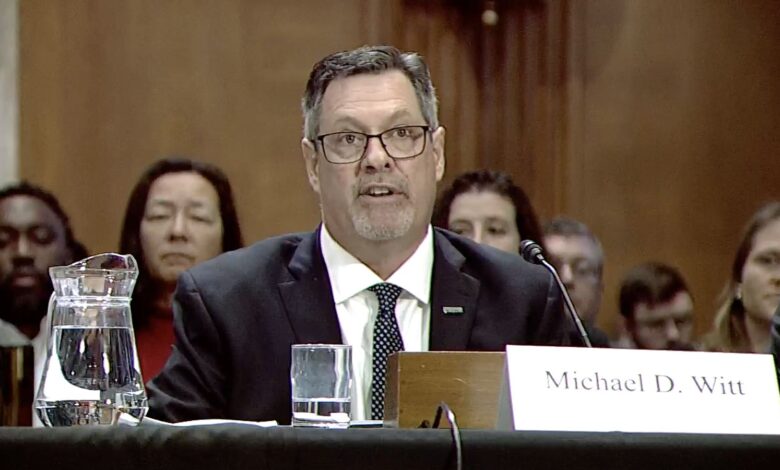Who Should Pay to Clean Up ‘Forever Chemicals’?

— Not us, representatives of water utilities and landfills say at a Senate hearing
by
Joyce Frieden, Washington Editor, MedPage Today
March 20, 2024
“Forever chemicals” are harming people and wildlife and should be removed from the soil and water, but who should pay to do that? Witnesses at a Senate Environment and Public Works Committee hearing Wednesday didn’t agree on the answer.
The chemicals, called per- and polyfluoroalkyl substances (PFAS), are used in all kinds of household and industrial products — including firefighting foam and dental floss — and have been found in air, soil, and water. They have been associated with liver damage and various types of cancers.
Water utilities should not be held responsible for the damage done by PFAS, said Michael Witt, JD, general counsel for the Passaic Valley (New Jersey) Sewerage Commission (PVSC), who testified on behalf of the Water Coalition Against PFAS. “We do not manufacture PFAS; we do not profit from PFAS — industry did that for decades,” he said.
“In contrast, utilities passively received PFAS via drinking water supplies and through influents,” he continued. “That fact, and that fact alone, exposes each and every utility in a potential liability under CERCLA [the Comprehensive Environmental Response, Compensation, and Liability Act, also known as the Superfund law] — and it exposes our rate-payers to having to pay for the problem of funding PFAS cleanups. This is simply wrong and Congress must act to fix it.”
He noted that his own utility company has been involved for decades in a lawsuit over the dumping of TCDD — a contaminant of the herbicide Agent Orange — into the Passaic River by manufacturer Diamond Alkali. “The damage that the company did will run into the billions of dollars to remediate. It is difficult to imagine a more culpable party” than Diamond Alkali, and yet its “successor interests have been able to drag — through decades of litigation — hundreds of parties including PVSC and 40 other public entities into this fight,” he said. Witt estimated that his utility company had spent $4.6 million in legal fees related to the case over the last 8 years.
Wastewater treatment facilities also shouldn’t be held responsible, said Robert Fox, JD, a partner at the law firm Manko, Gold, Katcher & Fox, who testified on behalf of the National Waste and Recycling Association and the Solid Waste Association of North America. The Environmental Protection Agency (EPA) “has proposed listing [two PFAS-related compounds] as hazardous substances under CERCLA,” he noted. However, “PFAS compounds are ubiquitous in consumer products, including nonstick cookware … nail polish, and carpets. Once discarded, these materials are ultimately disposed of in municipal solid waste landfills.”
“As a result, landfills are and were passive receivers of these waste streams containing PFAS,” he continued. “They never manufactured or use PFAS in their operations; they receive them due to the presence in waste created by virtually every person in this country. There is no practical way for landfills to identify or segregate household waste containing PFAS from general waste,” so designating them as hazardous substances requiring remediation without giving waste processors an exception “would compel landfills to restrict inbound waste with elevated levels of [PFAS] compounds … As a result, EPA’s goal of promptly remediating PFAS contamination at other sites will be delayed and frustrated … It will completely disrupt the well-established municipal waste infrastructure in this country.”
But Scott Faber, JD, senior vice president of government affairs of the Environmental Working Group in Washington, D.C., disagreed. “I think it’s a mistake to refer to folks as passive receivers,” he said. “Landfills, waste managers, and water utilities elect to receive these wastes. They can refuse these wastes; they can require their customers to pretreat these wastes; they can require them to provide records of this waste. This is nothing new for waste managers and water utilities — there are hundreds of these hazardous substances that they manage every day.”
“More than 600 hazardous substances are still being produced, and more than 300 are being produced in high volume, including sulfuric acid,” he added. “Hundreds are already found in landfills, and 66 are found in drinking systems.”
Committee Chairman Sen. Tom Carper (D-Del.) asked witnesses what the U.S. could learn from other countries about how to address this problem.
James Kenney, secretary of the New Mexico Environment Department, noted that “utility operator training in the United States is not on the front of our educational systems. Learning how to treat drinking water, especially from the STEM [science, technology, engineering, and math education] perspective, is something we could invest in from the federal level.”
Faber had another suggestion. “Other countries are racing to eliminate needless uses of PFAS,” he said. “We are falling behind the rest of the world when it comes to eliminating these uses of PFAS in carpets, clothing, and the things we bring into our homes … We should put burden on industry to say why these things are absolutely necessary.”
Carper also wanted to know what the witnesses could agree on.
Faber said he thinks “all of us agree that we should develop a drinking water standard [for PFAS] … And that we shouldn’t make this problem bigger, and allow manufacturers to continue to discharge this chemical with no limits at all.”
Currently, “likely more than 30,000 companies are discharging PFAS into our air and water right now … I feel this is an area where there’s opportunity for real progress,” he added.
Fox pointed out that “the guiding principle under Superfund is that the polluter pays, and we don’t want those paying to be rate-payers and taxpayers.”
-
![author['full_name']](https://clf1.medpagetoday.com/media/images/author/JoyceFrieden_188.jpg)
Joyce Frieden oversees MedPage Today’s Washington coverage, including stories about Congress, the White House, the Supreme Court, healthcare trade associations, and federal agencies. She has 35 years of experience covering health policy. Follow


